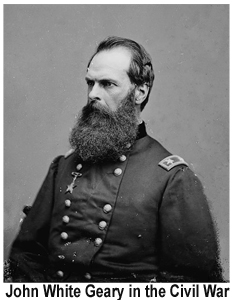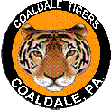Rahn township was formed out of West Penn in 1860. It is a coal township, though some timber tracts are still within it, and in the Owl Creek valley a few farms indicate an attempt at agriculture. The population was 1,227 in 1870, and 2,131 in 1880.
Berkhard Moser was the original settler. Together with one Houser he took up a track of 2,000 acres, which was partially brought under cultivation. The first discovery of coal was made where Greenwood slope is now located.
Greenwood breaker property was opened successfully about 1838, and up to 1860 the output was nominal. Charles F. Shoener and William T. Carter became the owners in the latter year, and Mr. Shoener, purchasing the entire concern, made extensive improvements, costing $1,000,000, which returned him during the year fifty thousand dollars a month, and sold in 1866 for $500,000.
In the days of its greatest prosperity 700 men and boys were employed, and 100 cars of coal a day shipped to market. The breakers were burned down in 1874 by the Mollie Maguires and have never been rebuilt. Their partial ruins are standing today.
Number eight tunnel, at Coal Dale, was commenced in 1846, and coal was struck in 1849. The first contractors were Creedam, Peckham and Steele. The next contractor was Cortright. Since 1868 the Lehigh and Wilkes-Barre coal and Navigation Company have had charge. Four hundred men and boys are employed.
Number ten tunnel was started in April, 1861, and today is one of the most profitable worked of all the company's collieries. There are employed some 500 men and boys. A new breaker, built during the winter of 1880 and 1881, will greatly increase the shipments, and be the first breaker in the Panther Creek valley from which coal was sent direct to market. This colliery is on the Mammoth vein, which is here an average of sixty feet in thickness, and its tracks under ground are ten miles in length. The Dry Hollow breaker, or number eleven, very near number ten, was opened in 1875.
COAL DALE
Coal Dale is a scattered village, almost exclusively of framed buildings. The first dwelling houses were erected in 1846 and were composed of six blocks, two in each, standing were number eight culm banks now are, and known as Bugtown.
Houses were erected in 1848 at old Coal Dale, twelve double blocks on the Summit Hill road. New Wales, or New Coal Dale, began to receive attention in 1868 or 1869. The blocks on the line of Schuylkill and Carbon counties were put up in 1870. The Evangelical church was organized and its chapel completed in 1869. It is connected with the Barnesville circuit.
The Welsh Congregational church of Coal Dale was organized November 20th, 1871, with thirty members. Its pastor from that time to the present has been Rev. David E. Hughes. The neat framed church was built in 1876, and dedicated in January, 1877. The present membership of the church is 50. The Sunday-school was organized about 1860, the first superintendent being Rev. Mr. Hughes.
Coal Dale was created a post village in 1871, with Charles F. Goslie as postmaster, D.E. Hughes taking the place one year later and holding it ever since. Mr. Hughes is a useful man in his community, serving the people as a justice of the peach, postmaster, storekeeper and preacher. Few men wield a better influence than he does among his countrymen.
GEARYTOWN
Gearytown was first brought to notice in 1866. A dwelling was erected in October of that year, and occupied by Richard Boyd. The town was named in honor of the then Governor, John W. Geary. The Bull Run houses were put up by the company in 1864. Shortly after the mines began working the population rapidly increased, and many blocks of houses were built, all by the company.
The Primitive Methodist church, Rev. E Davis pastor, was organized and St. John's chapel built in 1877, when Rev. Daniel Savage was the pastor. It is a modest framed edifice at the valley and summit cross roads, costing some $700.

(John White Geary (December 30, 1819 – February 8, 1873) was an American lawyer, politician, Freemason, and a Union general in the American Civil War. He was the final alcalde and first mayor of San Francisco, a governor of the Kansas Territory, and the 16th governor of Pennsylvania)
EDUCATIONAL AND OTHER INTERESTS
The school interests of Rahn are carefully looked after by a board of directors annually elected. There are five schoolhouses, nine schools and nine teachers.
In Coal Dale and vicinity, Bull Run, Gearytown, Centreville, Spring Tunnel and Dry Hollow there are about 255 dwelling houses, 380 in the whole township, and about 370 families. Over 100 dwelling houses have been built since 1869.
The merchants in Coal Dale are W.S. Hobart & Co., (company store), Thomas downs, E.G. Zern, and T.E. Powell. Since 1873 the Central Railroad of New Jersey has run regular passenger trains east and west each day, and the old stage line is abandoned.
The Mollie Maguires ran riot for many years through the Coal Dale end of the district, and in common with other sections for a time the law had no force; but the rightful state of things returned in 1875, with the check brought to bear upon the organization of murderers, and peace and order are now the rule, and not the exception.

